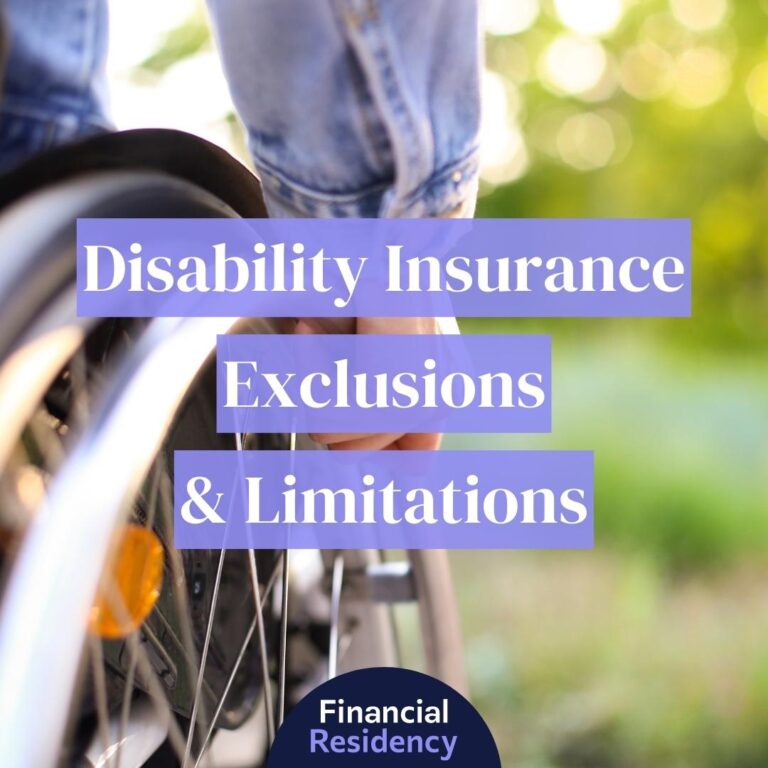A long-term disability insurance policy can provide years of vital coverage if you’re unable to work. Disability coverage is easy to customize, with several optional riders that can enhance your policy’s benefits.
Before you purchase a disability policy, it’s important to understand all of the add-ons you have access to so you can build a policy that fits your unique needs.
In this guide, we’ll explore the most common disability insurance riders and explain how they work.
The Importance of Disability Riders
Disability insurance riders can extend your policy benefits to provide more comprehensive coverage. In addition to providing additional coverage, riders make your insurance coverage more flexible.
Riders can also provide tailored coverage for specific professions, like a student loan protection rider to help young physicians pay off large student loans.
Disability insurance isn’t a one-size-fits-all product. Rather than including policy features that are only useful to some people and driving up the cost of coverage, disability insurance companies lower costs and make coverage more efficient with optional riders.
Common Disability Insurance Riders
As you compare the riders below, think about how each one might apply to your situation and help you protect your income:
- Enhanced Partial Disability Rider
- Basic Partial Disability Benefit Rider
- Mental, Psychiatric, and Substance Abuse Benefit Limitations
- Future Increase Option (FIO)
- Benefit Purchase & Benefits Update Riders
- Cost of Living Adjustment Riders (COLA)
- Own Occupation Rider
- Student Loan Protection Rider
- Lump Sum Benefit Rider
- Retirement Protection Rider
- Catastrophic Disability Benefits Rider
- Waiver of Premium Rider
- Presumptive Total Disability Rider
- Death/Survivor Benefit
Enhanced Partial Disability Rider
An enhanced partial disability benefit rider offers a higher benefit for the first 12 months if you’re partially disabled and experience a 15% loss in income.
This residual disability benefit rider will pay the full amount of income you’ve lost for the first 12 months, after the elimination period, up to the benefit amount.
The Enhanced partial disability benefit rider also includes a guarantee that if you lose less than 50% of your income, your insurer will not pay less than 50% of the total disability benefit during the first 12 months.
After the initial 12-month period, an enhanced partial disability benefit rider changes the benefit you can receive to a percentage-based formula.
Basic Partial Disability Benefit Rider
Alternatively, the basic partial disability benefit rider offers a shorter dollar-for-dollar benefit period.
It requires a 20% loss in income resulting from a disability that leaves you unable to perform key duties of your occupation at the rate you normally would.
After the elimination period, the partial disability benefit rider pays a proportionate percentage of your total benefit. For example, if you lose 50% of your income, the rider would pay 50% of your total benefit.
During the first 6 months, a basic partial disability benefit rider guarantees to pay at least 50% of your total disability benefit. After 6 months, payments are proportionate based on the percentage of income lost.
Mental, Psychiatric, and Substance Abuse Benefit Limitations
Another piece to consider as you compare policies is the mental, psychiatric, and substance abuse benefit limitations.
Some policies limit the benefit period for conditions in these categories to 24 or 60 months, while others pay benefits until age 65. A few insurers offer unlimited mental health riders.
If you’re seeking a policy that offers a longer mental, psychiatric, and substance abuse benefit term, be sure to review the provisions of each policy and weigh the added premium for a rider with a longer benefit period.
Conversely, you may be able to lower premiums by adding a mental limitation rider to your policy.
Future Increase Option (FIO)
A future increase option rider, or future purchase option, gives you the option of increasing your benefit in the future. This rider can be a great option for residents, as their income will increase drastically within a few years.
You can preselect the amount of additional benefits you want access to, with the option to increase your benefit at each policy anniversary.
There isn’t usually a medical underwriting requirement unless you’re currently disabled; however, a review of your financial information is typically required. If you decide to increase your benefit amount, your premium is increased proportionally.
Benefit Purchase & Benefit Update Riders
You can also increase your disability insurance benefits through a benefit purchase or benefit update rider.
Every three years, the insurance company will review your eligibility based on your current income. You’ll be eligible to take the full amount they offer you each time. In order to keep this free rider, you’ll need to accept at least half of the new benefit amount they offer you.
The benefit purchase or benefit update rider also allows you to increase your benefit amount if your income increases significantly.
Cost of Living Adjustment Riders (COLA)
Money becomes less valuable over time due to inflation. If you purchase a policy for $1,000 and the cost of living adjustment isn’t keeping up with inflation, your policy could be losing value over time.
A cost of living adjustment rider (COLA) helps ensure that your total benefit amount keeps up with inflation. They can use either a fixed or variable rate. Variable rates are tied to the Consumer Price Index.
A COLA rider may increase your benefits with a compounded rate or a simple rate. Compounding rates are similar to compounding investment returns over time. However, a simple rate is only applied once.
Own Occupation Rider
Own-occupation coverage is a must if you’re a doctor. It allows you to file a disability claim if you can’t fulfill the duties of your job, specifically. So even if you’re able to perform in a different role, you’ll still get the monthly benefits from your policy.
Some insurers automatically offer own occupation coverage, but others may require you to purchase a rider to change the definition of your policy’s terms.
Student Loan Protection Rider
As a physician, you may also want to consider a student loan protection rider. According to the Education Data Initiative, the average doctor has $250,000 in student loan debt.
When you make such a large investment in your education, it’s important to protect it. The student loan protection rider allows you to increase your overall coverage amount to account for student loan payments.
Just weigh the cost of this rider and remember that there are alternatives. If you have federal student loans, you may qualify for a total and permanent disability (TDP) discharge of your debt.
Lump Sum Benefit Rider
Some insurers offer a lump sum benefit option, which pays out a bonus benefit at the end of your policy’s benefit period or at a set age.
The terms can vary from one insurance carrier to the next, but this type of rider usually pays out a set percentage of your policy’s benefits.
For example, Guardian pays out 35% of the total amount you’ve received in benefits over the life of your policy when you reach age 60.
If you don’t have extensive savings, this rider could be a wise addition to your policy that ensures you can pay medical bills later in life.
Retirement Protection Rider
Your savings can take a major hit when you’re disabled. While disability insurance is primarily designed to shield you against loss of income, it can also account for lost retirement savings.
A retirement protection rider is made to continue making contributions to your retirement accounts as you would before you became disabled.
If you have the means to factor your retirement into your policy, this rider could be a sound investment into your future.
Catastrophic Disability Benefits Rider
A catastrophic disability rider provides truly comprehensive coverage, replacing as much as 100% of your income in some cases.
This rider takes effect when you are catastrophically disabled and unable to carry out at least two activities of daily living. That includes activities such as bathing, feeding yourself, or getting dressed.
Waiver of Premium Rider
Most disability insurance policies include this complimentary rider, which waives your monthly premiums while you’re disabled and receiving benefits.
If you recover and return to work, your premium payments will resume.
Some insurance companies extend this benefit for a short period of time after you’ve recovered and return to work.
Presumptive Total Disability Rider
Standard total disability policies start paying out after the policy’s waiting or elimination period, which could range from 30 days to two years.
With this rider, you can start receiving benefits immediately if you lose the ability to speak, hear, see out of both eyes or use at least two limbs.
Death/Survivor Benefit
Some long-term disability policies also come with an optional death benefit. If the policyholder passes away while they’re receiving benefits, their beneficiary will be paid a monthly benefit for a set period of time.
For instance, some insurers limit the death benefit to the first of 12 months of payments or the policy’s maximum benefit. There may also be an exclusion for policies that have been in effect for less than a year.
Frequently Asked Questions
What disability insurance riders are free?
Most disability insurance policies include free guaranteed renewable and non-cancelable riders. These features ensure that your coverage will not lapse as long as you make payments on time and that your rates will not increase over time.
Waiver of premium and automatic increase benefit riders are often included for free as well.
Does life insurance cover disability?
Life insurance policies don’t automatically provide coverage for disabilities, but you can typically add on a disability rider to your coverage.
If you have disability income insurance, you should have adequate coverage and can save money by foregoing a disability rider on your life insurance policy.
Learn More:
Is a residual disability rider worth it?
While a residual disability rider increases premiums, it can be worth the added cost if you suffer from an accident or illness that leaves you partially disabled but reduces your income.
Learn More:
Bottom Line
Long-term disability insurance is a detailed product, and it can be difficult to narrow down the options to find the right policy for your needs.
Compare the benefits and costs of each rider to decide which ones are the best fit for your needs. You can also consult with an insurance agent or financial advisor to tailor your coverage.
Before you purchase a policy, be sure to compare quotes and understand the terms of the coverage.



